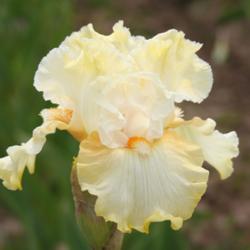The Flower Patterns field is one of the most useful, but also confusing, aspects of the Iris Database here at ATP. To help you get the most from the database, here are brief explanations of what these words mean.
Before we begin, there are a couple of caveats. First, there are no "official" definitions of these terms. Irisarians generally understand what they mean, but as they will with any generally understood term, reasonable people will disagree on the exact definition. Second, iris genetics are complex and many varieties defy being put into neat little boxes. With that in mind, let's have a look at Iris flower patterns.
Self: Standards and falls are the same color.
Bitone: Standards and falls are different shade of the same color, falls are darker.
Reverse Bitone: Standards and falls are different shade of the same color, standards are darker.
Bicolor: Standards are a different color from the falls
Variegata: A specific type of bicolor where the standards are yellow(ish) and the falls are brown(ish) to purple(ish)
Amoena: A specific type of bicolor where the standards are white and the falls are colored.
Reverse Amoena: An amoena with colored standards and white falls.
Neglecta: Usually described as "blue or purple bitones", but I like to think of them as blue or purple amoenas with light blue(ish), rather than white, standards.
Emma Cook: Derived from amoena/bicolor breeding, but with just a band of pigmentation around the border of the falls.
Debby Rairdon: Colored standards, white falls with a band of standard color around the edges. Often yellow, but can be peach, pink, etc. as well.
Blend: Combination of two or more colors, can be smoothly or unevenly mixed.
The next four categories are in what might be called the "plicata group", they are genetically related.
Plicata: Has a light ground color with anthocyanin pigment stippled, dotted, or stiched around the margins of the flowers.
Luminata: Could be described as a "reverse plicata." As in a plicata, the flower has a light ground color, but the anthocyanin pigment covers the centers of the petals, with the ground color mostly showing around the edges of the petals, at the hafts, and in the style arms.
Glaciata: Essentially a plicata with no anthocyanin pigment.
Broken: Light ground with random splashes of color.
Lastly we have:
Line and Speckles: I can't say that I understand the genetics behind this pattern very well although it may involve a combination of plicata and non-plicata genes. If you look deeply enough into the parentage of these plants, you will almost always find
Tall Bearded Iris (Iris 'Goldkist'),
Tall Bearded Iris (Iris 'Starring'),
Tall Bearded Iris (Iris 'Wild Jasmine'),
Tall Bearded Iris (Iris 'Impulsive'), and/or
Tall Bearded Iris (Iris 'Decadence') somewhere in the lineage.



